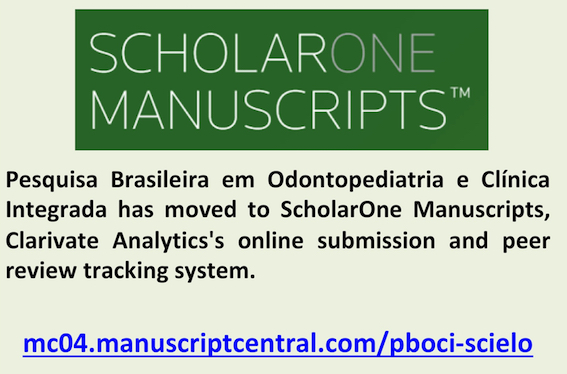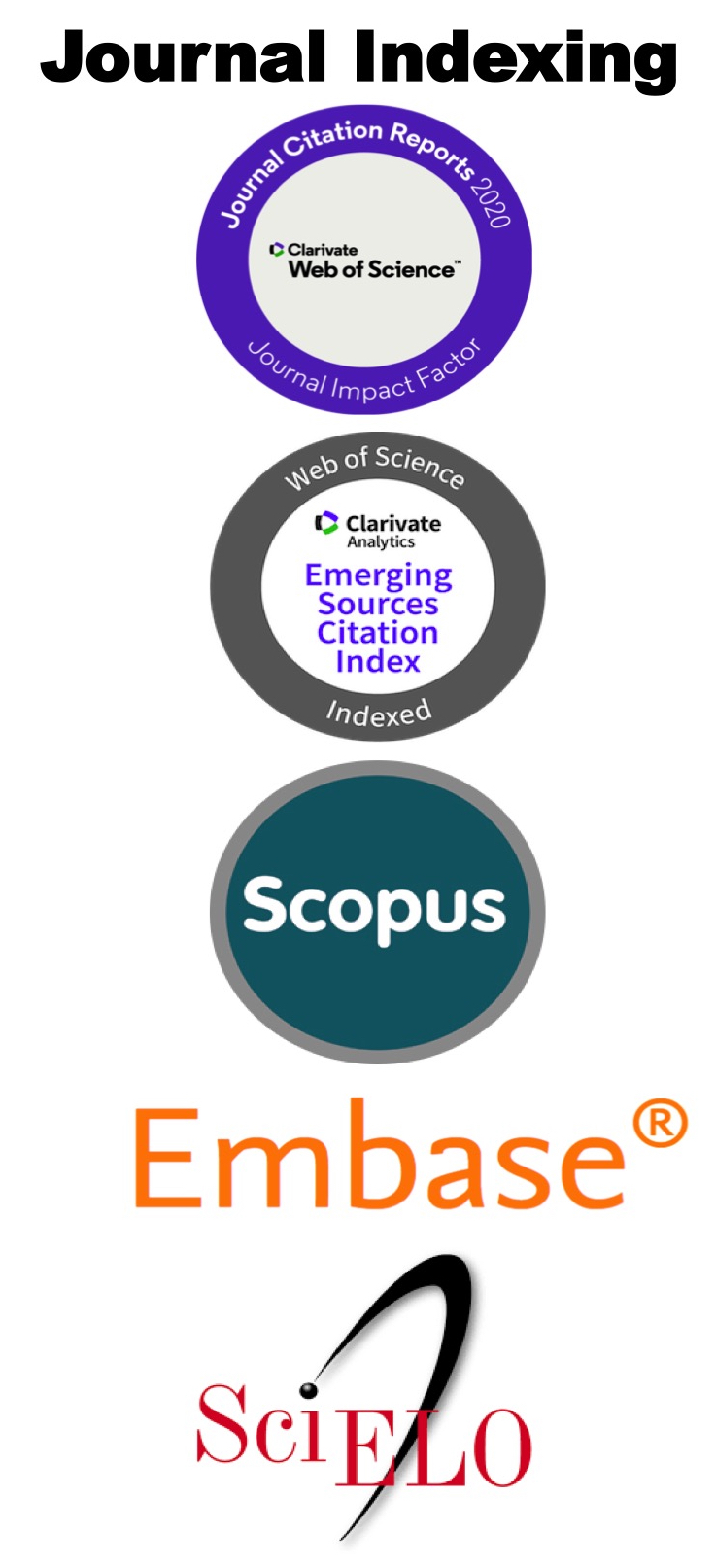Prevalence of Craniofacial Anomalies - 14 Years of Experience in a Brazilian Referral Service
Keywords:
Congenital Abnormalities, Craniofacial Abnormalities, Cleft Lip, Cleft Palate, EpidemiologyAbstract
Objective: To delineate the frequency of congenital craniofacial anomalies (CCAs) in a Brazilian reference center. Material and Methods: A cross-sectional, retrospective epidemiological study was conducted, updating information from the reference center. Data were extracted from the medical records of patients assisted between January 2009 and December 2022 at the Craniofacial Anomalies Rehabilitation Center (Centro Pró-Sorriso) in Alfenas, Brazil. Previous studies were used as a reference for the classification of CCAs. Data were analyzed using statistical software for absolute and relative frequency descriptive analysis. A 95% confidence interval was adopted. Study approved by ethics and research committee. Results: 817 records were analyzed, comprising 53.5% males and 46.5% females. Identified 954 congenital anomalies (CAs); of these, 86.9% of cleft lip and/or palate (CL/P), 16.0% of CAs without CL/P, and 2.8% of syndromes or sequences recognized in the absence of CL/P. The CAS most commonly associated with any CL/P were cardiovascular system anomalies (23%), and the most common CL/P was cleft palate (48.7%). Conclusion: Among the CAs, CL/P was the most prevalent, exhibiting a higher ratio in males. Following CL/P, ear anomalies were the most commonly observed; however, when associated with the presence of any CL/P, cardiovascular system anomalies were more numerous. Regarding the presence of syndromes and/or sequences, Goldenhar Syndrome was more prevalent in cases without an association with clefts.
References
World Health Organization. Birth defects surveillance atlas of selected congenital anomalies. Geneva: World Health Organization; 2014. Available from: https://www.who.int/publications/i/item/9789241548724 [Accessed on September 29, 2023].
Luz G dos S, Karam S de M, Dumith SC. Congenital anomalies in Rio Grande do Sul State: A time series analysis. Rev Bras Epidemiol 2019; 22:e190040. https://doi.org/10.1590/1980-549720190040
Larrandaburu M, Vieira MT, Luiz F, Nacul L, Schuler L. Frequent congenital anomalies in Uruguay between 2011 and 2014: Importance of a registry for the evaluation of health needs. Arch. Pediatr Urug 2022; 93(1):e202. https://doi.org/10.31134/ap.93.1.12
De Stefani RR, Böckmann BS, Soska Baldissera GS, Scherer MH, Lüdtke M, Signor ND. Birth defects: Main known etiologies, population impact and the need for monitoring. Acta Méd 2018; 39(1):155-184.
World Health Organization. Center for Disease Control and Prevention – CDC. International Clearinghouse for Birth Defects Surveillance and Research - ICBDSR. Birth defects surveillance: A manual for programme managers. Geneva: World Health Organization; 2014. Available from: https://www.who.int/publications-detail/9789241548724. [Accessed on September 28, 2023].
World Health Organization. Congenital anomalies. Geneva: World Health Organization; 2016. Available from: https://www.who.int/news-room/fact-sheets/detail/congenital-anomalies [Accessed on September 29, 2023].
Yu Z, Li D, Sun L, Zhao X, Chang H, Cui L, et al. Long-term trends in the incidence of congenital anomalies in Central China from 1997 to 2019. Public Health 2022; 203:47-52. https://doi.org/10.1016/j.puhe.2021.12.007
Anane-Fenin B, Opoku DA, Chauke L. Prevalence, pattern, and outcome of congenital anomalies admitted to a neonatal unit in a low-income country-a ten-year retrospective study. Matern Child Health J 2023; 27(5):837-849. https://doi.org/10.1007/s10995-023-03591-x
Wiechers C, Thjen T, Koos B, Reinert S, Poets CF. Treatment of infants with craniofacial malformations. Arch Dis Child Fetal Neonatal Ed 2021; 106(1):104-109. https://doi.org/10.1136/archdischild-2019-317890
Morrison D, Kesser B. Congenital anomalies of the ear canal. Otolaryngol Clin North Am 2023; 56(5):933-948. https://doi.org/10.1016/j.otc.2023.06.007
Amstalden-Mendes LG, Xavier AC, Antunes DK, Ferreira AC, Tonocchi R, Fett-Conte AC, et al. Time of diagnosis of oral clefts: A multicenter study. J Pediatr 2011; 87(3):225-230. https://doi.org/10.2223/jped.2084
Paranaíba LMR, Miranda RT de, Ribeiro LA, Barros LM de, Martelli-Júnior H. Frequency of congenital craniofacial malformations in a Brazilian Reference Center. Rev Bras Epidemiol 2011; 14(1):151-160. https://doi.org/10.1590/S1415-790X2011000100014
Vallino-Napoli LD, Riley MM, Halliday J. An epidemiologic study of isolated cleft lip, palate, or both in Victoria, Australia from 1983 to 2000. Cleft Palate Craniofac J 2004; 41(2):185-194. https://doi.org/10.1597/02-076
Jaruratanasirikul S, Chichareon V, Pattanapreechawong N, Sangsupavanich P. Cleft lip and/or palate: 10 years experience at a pediatric cleft center in Southern Thailand. Cleft Palate Craniofac J 2008; 45(6):597-602. https://doi.org/10.1597/07-176.1
Spina V, Psillakis JM, Lapa FS, Ferreira MC. Classification of cleft lip and cleft palate. Suggested changes. Rev Hosp Clin Fac Med São Paulo 1972; 27(1):5-6.
Babai A, Irving M. Orofacial clefts: Genetics of cleft lip and palate. Genes 2023; 14(8):1603. https://doi.org/10.3390/genes14081603
Tomatir AG, Demirhan H, Sorkun HC, Köksal A, Ozerdem F, Cilengir N. Major congenital anomalies: A five-year retrospective regional study in Turkey. Genet Mol Res 2009; 8(1):19-27. https://doi.org/10.4238/vol8-1gmr506
Aziza A, Kandasamy R, Shazia S. Pattern of craniofacial anomalies seen in a tertiary care hospital in Saudi Arabia. Ann Saudi Med 2011; 31(5):488-493. https://doi.org/10.4103/0256-4947.84626
Farhan TM, Al-Abdely BA, Abdullateef AN, Jubair AS. Craniofacial anomaly association with the internal malformations in the pediatric age group in Al-Fallujah City-Iraq. Biomed Res Int 2020; 4725141. https://doi.org/10.1155/2020/4725141
Zarante I, López MA, Caro A, García-Reyes JC, Ospina JC. Impact and risk factors of craniofacial malformations in a Colombian population. Int J Pediatr Otorhinolaryngol 2009; 73(10):1434-1437. https://doi.org/10.1016/j.ijporl.2009.07.012
Dixon MJ, Marazita ML, Beaty TH, Murray JC. Cleft lip and palate: Understanding genetic and environmental influences. Nat Rev Genet 2011; 12(3):167-178. https://doi.org/10.1038/nrg2933
Rodrigues K, Sena MF de, Roncalli ÂG, Ferreira MÂF. Prevalence of orofacial clefts and social factors in Brazil. Braz Oral Res 2009; 23(1):38-42. https://doi.org/10.1590/S1806-83242009000100007
Polanski JF, Kliemann BS, Freyhardt E, Tonocchi RDC, Freitas RDS. Study of the prevalence of morphological varieties of cleft lip and palate in a tertiary medical center. Rev Bras Cir Plást 2020; 35(4):389-393. https://doi.org/10.5935/2177-1235.2020RBCP0070
Raut JR, Simeone RM, Tinker SC, Canfield MA, Day RS, Agopian AJ. Proportion of orofacial clefts attributable to recognized risk factors. Fissura Palatina Craniofac J 2019; 56(2):151-158. https://doi.org/10.1177/1055665618774019
Silva HPV da, Arruda TTS, Souza KSC de, Bezerra JF, Leite GCP, Brito MEF de, et al. Risk factors and comorbidities in Brazilian patients with orofacial clefts. Braz Oral Res 2018; 32:e24. https://doi.org/10.1590/1807-3107bor-2018.vol32.0024
Daliri S, Safarpour H, Bazyar J, Sayehmiri K, Karimi A, Anvary R. The relationship between some neonatal and maternal factors during pregnancy with the prevalence of congenital malformations in Iran: A systematic review and meta-analysis. J Matern Fetal Neonatal Med 2019; 32(21):3666-3674. https://doi.org/10.1080/14767058.2018.1465917
Martelli DRB, Machado RA, Swerts MSO, Rodrigues LAM, Aquino SN de, Martelli Júnior H. Non sindromic cleft lip and palate: Relationship between sex and clinical extension. Braz J Otorhinolaryngol 2012; 78(5):116-120. https://doi.org/10.5935/1808-8694.20120018
Trezena S, Machado RA, de Almeida Reis SR, Scariot R, Rangel ALCA, de Oliveira FES, et al. Isolated non-syndromic cleft palate: Multicenter epidemiological study in the Brazil. BMC Oral Health 2023; 23(1):486. https://doi.org/10.1186/s12903-023-03197-3
Silva CM, Pereira MCM, Queiroz TB, Neves LTD. Family history in non-syndromic orofacial clefts: Is there a pattern? Oral Dis 2022; 28(8):2194-2203. https://doi.org/10.1111/odi.13942
Burg ML, Chai Y, Yao CA, Magee W 3rd, Figueiredo JC. Epidemiology, etiology, and treatment of isolated cleft palate. Front Physiol 2016; 7:67. https://doi.org/10.3389/fphys.2016.00067
Mossey PA, Little J, Munger RG, Dixon MJ, Shaw WC. Cleft lip and palate. Lancet 2009; 374(9703):1773-1785. https://doi.org/10.1016/S0140-6736(09)60695-4
Stoll C, Alembik Y, Roth MP. Co-occurring anomalies in congenital oral clefts. Am J Med Genet A 2022; 188(6):1700-1715. https://doi.org/10.1002/ajmg.a.62689
Paranaíba LMR, Almeida H de, Barros LM de, Martelli DRB, Orsi Júnior JD, Martelli Júnior H. Current surgical techniques for cleft lip-palate in Minas Gerais. Brazil Braz J Otorhinolaryngol 2009; 75(6):839-843. https://doi.org/10.1590/S1808-86942009000600011
Gonçales AGB, Silva CM, de Moraes Pereira MC, das Neves LT. Clinical characteristics in subjects with van der woude syndrome: An integrative review. Braz Appl Sci Rev 2019; 3(4):1809-1820. https://doi.org/10.34115/basrv3n4-009
Ferrari-Piloni C, Barros LAN, Jesuíno FAS, Valladares-Neto J. Prevalence of cleft lip and palate and associated factors in Brazil's Midwest: A single-center study. Braz Oral Res 2021; 35:e039. https://doi.org/10.1590/1807-3107bor-2021.vol35.0039
Tan TY, Kilpatrick N, Farlie PG. Developmental and genetic perspectives on Pierre Robin sequence. Am J Med Genet C Semin Med Genet 2013; 163C(4):295-305. https://doi.org/10.1002/ajmg.c.31374
Stoll C, Alembick Y, Roth MP. Associated anomalies in Pierre Robin sequence. Am J Med Genet A 2023; 191(9):2312–2323. https://doi.org/10.1002/ajmg.a.63344
Downloads
Published
How to Cite
Issue
Section
License
Copyright (c) 2024 Pesquisa Brasileira em Odontopediatria e Clínica Integrada

This work is licensed under a Creative Commons Attribution-NonCommercial 4.0 International License.



